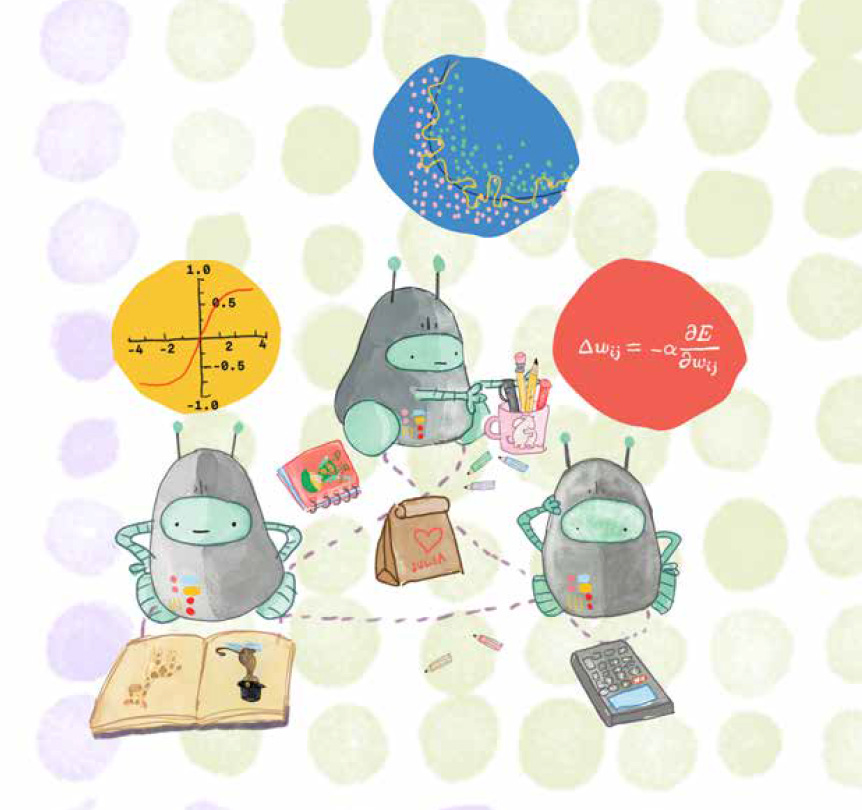No. 40 — Making AI visible 👀 Struggles with the strange 🏘️ Fictional livability index
Blueprints of imagination
My name is Linda. I write a bi-weekly newsletter about computer science, childhood and culture - and there are 9 603 of you listening. If you enjoy this issue, please share it with anyone you think may find it useful.
A few weeks ago I stumbled upon a project called Visualising AI by DeepMind. The technology company commissioned 3D artists and graphic designers to produce images around concepts like neural networks, artificial general intelligence and how data is transmitted through layers of computation. The illustrations can be freely used. (There’s also a similar project called Better Images of AI, which I really like.)
The end results are interesting and beautiful. At least compared to the dominant aesthetic of AI with blue brains made of circuits and humanoid robots, which we somehow got stuck with.
This is a familiar problem for me. Already in 2018 when I was first illustrating the Hello Ruby book on AI, I would struggle with the strangeness of trying to illustrate something invisible. Metaphors like drawings can help us describe technologies, but they also leave us in a lurch. This is what I worry about when I see children copying my illustrations, mimicking the robot and the code.
Anyways, four years later I’m still thinking of how to build activities around making AI visible.
This time the process is led much more by children, with materials that engage multiple senses, generate interaction and promote attention. I’ve been slowly building a materials library to a project we with algae, mushrooms, rocks, pinecones, egg shells and tissue paper.
As an illustrator, I often miss the sensitivity, humour and pleasure children bring into the creative process.
As an educator, I recognise the wisdom children bring into the sense-making, how they (like Reggio Emilia states) multiply their knowledge about the world with strange and beautiful end results. Maybe out of this process, new visualisations for AI will emerge.
Linked List
In computer science, a linked list is a linear collection of data elements whose order is not given by their physical placement in memory. But here it is a selection of things I’ve been reading lately.
Blueprints of Intelligence on Noema Magazine does a much better job in framing the discussion around AI illustrations than I do.
An interesting point by Tobias Revell - the DeepMind illustrations don’t actually use any of the DeepMind tools. And currently the most visible illustration of AI is the DALL-E meme prompt AI aesthetic.
The fictional livability index is a ranking and review of twenty towns, villages and cities from various works of fiction and through them observes some of the challenges of indexes like these. If I had to settle in a fictional literary universe I would probably choose Astrid Lindgren’s Bråkmakargatan or Koriko from Kiki’s Delivery Service. What about you?
One of my favorite books, Code by Charles Petzold, is getting an expanded second edition, with interactive illustrations on a website. Power of books - the first edition came out twenty three years ago!
Classroom
I’m hoping to surface and share stories from all of you and I’d love to see your creations! Here are a few teachers using Ruby in creative, fun and inspiring ways.





Summer learning at its best!
There is a nice, short video of the German edition of Ruby to see!
Hello Ruby came out in Iran and I’ve been enjoying seeing all the activities around the book at the Tehran book fair and elsewhere (more on these later!). Here’s a short video of the outdoors art & algorithms activity they did.






